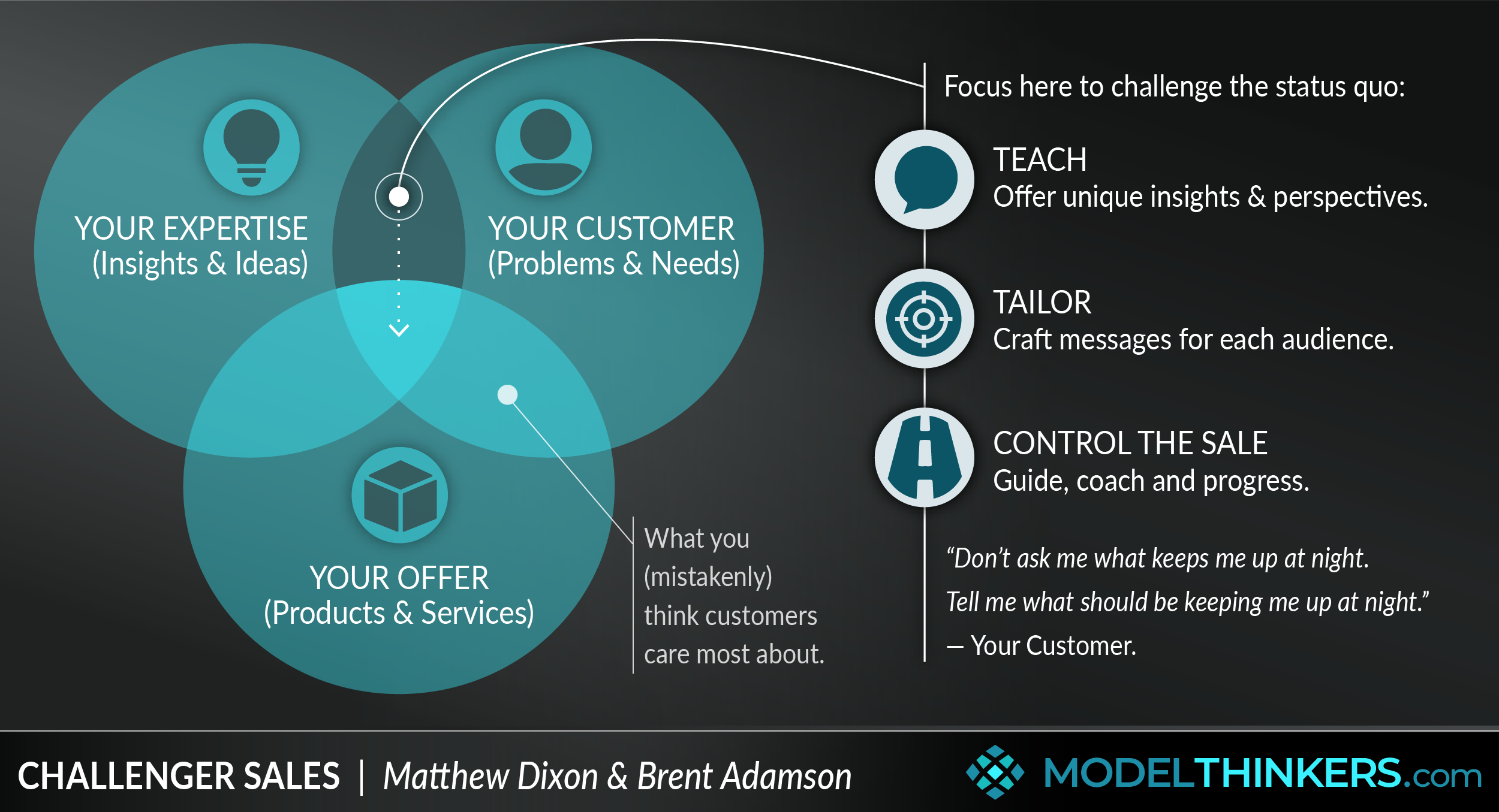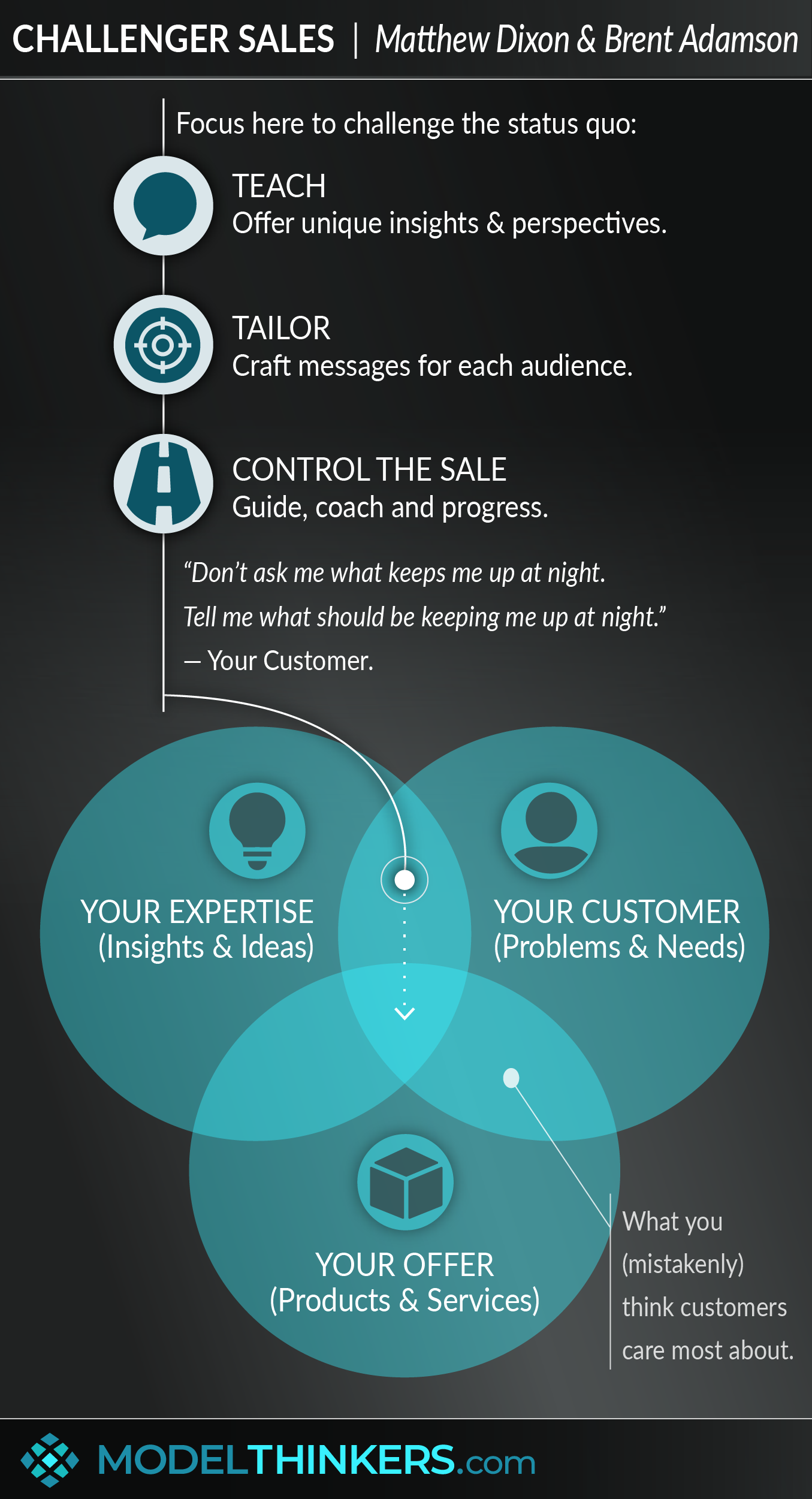

 0 saved
0 saved
 21.8K views
21.8K views








You're in sales.
It mightn't be obvious, especially if you're not running a startup or you don't have 'sales' or 'business development' in your job title. But, the fact is whether you’re in IT, HR, operations, management or any role, you’re still selling. Especially when you view sales as the art of influencing people to ‘buy into’ the value that you have to offer.
And, when you embrace that fact, you’ll benefit from experimenting with Challenger Sales.
Challenger Sales involves teaching the customer, providing new perspectives about how they might realise greater value; tailoring the message for specific audiences; and taking control of the sale by being professional, highlighting the cost of doing nothing, and holding your ground.
Matthew Dixon, one of the founders of the model explains: “In a world where customers can learn on their own, what they want from you is the thing they couldn’t learn. They want your perspective, a unique idea, something that they might have overlooked.”
FIVE SALES ARCHETYPES.
Authors of The Challenger Sale, Brent Adamson and Matthew Dixon as well as the team at CEB developed this approach by studying thousands of sales reps and identifying five sales archetypes:
-
The Relationship Builder: a common choice for sales reps who are generous with their time, build networks and ask questions. They represent 7% of top sales performers.
-
The Problem Solver: detailed-orientated reps focused on solving problems, even over sales. 12% of top sales performers.
-
The Hard Worker: super motivated, always going the extra mile with high resilience. 17% of top performers.
-
The Lone Wolf: Follow strong instincts, self-assured, hard to manage or scale but get results. 25% of top performers.
-
The Challenger: Loves to debate and is happy to push the limits, has deep experience and offers insights that challenge the status quo. 39% of top performers.
Interestingly, for complex sales, CEB found that 54% of high performers were Challengers. Further, The Challenger Group, a breakaway consultancy from CEB (see Origins & Resource below for more), recently found that Challengers grew to 48% of top performers for general sales over the 2020 Coronavirus period.
BEHIND CHALLENGER RESULTS.
One of the key findings from the original research was that customers are conducting greater due diligence and research by themselves, and engaging with a shortlist of vendors late in their journey. There's not much between that shortlist so, at that point, customers will most value unique insights and new perspectives that challenge the views that they’ve developed.
Indeed, CEBs research showed that when ranking customer loyalty — which highlighted the choice between the preferred and next best vendor — the role of company and brand as an influencing factor was rated at 19%; product and services was also 19%; value to price ratio was 9%. And, surprisingly, the sales experience, and in particular the level of new insights offered during that experience, contributed to a massive 53%.
INSIGHTS, THEN QUESTIONS.
While modern sales has been built around asking questions upfront, Matt Dixon describes a conversation with a CIO who pointed out that a typical sales rep has likely met more CIOs and seen more varied contexts than she ever would in her career. As a result, rather than being asked the typical, “what’s keeping you up at night?”, the CIO wanted the sales rep to draw on their experience and expertise to tell her “what should be keeping her up at night.”
It’s not to say that the Challenger Model is all about telling, you will still ask questions, but you will lead the engagement by establishing credibility with fresh insights and perspectives.
OTHER CHALLENGER TIPS.
The original research into this model tested forty-four sales attributes, and identified six as core to Challenger Sales:
-
Offers unique perspectives
-
Has strong two-way communication
-
Knows the individual customer’s value drivers
-
Can identify economic drivers of the customer’s business
-
Is comfortable discussing money
-
Can pressure the customer
Bringing that together, Challengers use their expertise, combined with a deep understanding of the customer’s business and value drivers, to challenge the status quo and create excitement about what’s possible. At the same time, the Challenger Sales rep will confidently position their offer as the means to help deliver that possible future.
NOT IN SALES? THEN READ THIS.
If you’re not in a sales role or running a start-up, but instead work in a company, use this model as a call to action to stop being a simple ‘order taker’ who silently fulfils narrow requests, and to go beyond being the ‘friendly networker’ and/or ‘diligent hard worker.’
Embracing Challenger Sales from an internal role is about finding the sweet spot between your expertise, and your understanding of stakeholder needs, so that you can challenge status quo thinking and provide unexpected value. Importantly, this value and new perspectives come in addition to the actual deliverables you might be known for — indeed it will allow stakeholders to better appreciate and realise greater value from those deliverables.
IN YOUR LATTICEWORK.
Challenger Sales will benefit from models related to influencing such as Cialdini’s Six Principles of Persuasion and sales-related heuristics such as Anchoring, Hyperbolic Discounting, Paradox of Choice, and Loss Aversion.
The process of challenging the status quo has much alignment with Framestorming and root-cause analysis models such as the 5 Whys.
Finally, use your understanding of Features vs Benefits, Value Proposition, Personas, and even Jobs To Be Done to assist you in tailoring your messages to specific customer or stakeholder needs.




-
Whether you're in a sales role or not, challenge to deliver value.
Create a stakeholder map to identify who you deliver value to. Consider your stakeholder's domain, needs, value-drivers and pain points. Then consider how your expertise, beyond your expected deliverables, can uncover greater value and new perspectives. This is about tapping into your knowledge of your customer via your unique perspective and expertise.
-
Tailor multiple messages.
Research behind Challenger Sales showed that, for complex sales decisions, senior executives cared whether employees and team members supported the deal. And that team members wanted to learn something from the sales rep. Therefore it makes sense to deliver a tailored message to various team members, connecting your insights with something they care about.
-
Build credibility — demonstrate relevance and expertise upfront.
Challenger Sales reps will quickly demonstrate their understanding of their customer’s business and industry by applying your unique perspective and domain knowledge.
-
Challenge the status quo by identifying the ‘problem behind the problem.’
A key part of the Challenger process is to offer insights to encourage a new perspective. This might involve a radical reframe or identifying an element that has not been considered.
-
Support the case with evidence and data.
You can lead with the high level emotional and passionate reframe, focusing on a sense of aspiration and ambition, but you also need to back it up with case studies, data and compelling evidence.
-
Build constructive tension.
Constructive tension lies between the current state and the picture of what's possible that you've empowered your customer to see. Part of 'controlling the sale' is creating a sense of urgency around this tension, particularly highlighting the cost of doing nothing or delaying.
-
Take control of the sales conversation.
The Challenger model highlights the importance of boldness in negotiations without being overly pushy. For example, you might make an early request to know when and how a senior stakeholder will be involved to assess the actual level of interest in the sales process as part of your qualification.
-
Ensure buy-in on the approach, then raise your offer.
Once you’ve won over people to the approach, perspective and reframe, then, and only then, do you position your offer as a means to achieve that goal. As a result, it's likely that you'll talk about specific products or services late in the piece.
The reception of Challenger Sales has been generally positive, with the book becoming a key influencer in sales teams worldwide, though that hasn’t stopped authors such as Geoffrey James from Inc Magazine critiquing the model for being unoriginal.
Specifically, James argues that the core approach, where salespeople approach customers with unique insights about how they can save money, can be traced back to the 1970s and has been repackaged in this model.
The authors of the book acknowledge that they did not 'invent' this approach, rather they gathered the data and created a narrative around it. Indeed, they even acknowledge they were even beaten to going public by an article in HBR that prompted insight-based selling (see Origins & Resources for more).
Perhaps a more substantial critique by James and others is the notion that ‘you must take control of the sales process.’ In my own research, I found that aspect of the model the hardest to translate into practical and specific steps, and James points out that most customers will revolt at any sense of a ‘hard sell.’
To be fair, the authors definitely do not advocate hard-selling, but emphasise the need to maintain your agenda and work consciously towards it. It's still an area that lacks practical advice which given it's a potential minefield, could be seen as a limitation.
Finally, in terms of practical execution, it can be difficult to establish credibility quickly enough to engage with customers/ stakeholders. You run the risk of simply telling or, dare I say, of 'mansplaining' unless it's executed skillfully. And, even when that upfront credibility piece is done well, an opportunity to challenge the status quo that aligns neatly with your offer still might be elusive.
Selling furniture.
The Challenger Sales book offers the example of a sales rep from an office furniture company meeting with someone who has built a new building. The authors outline six steps that such a sales rep might take:
-
Build credibility with a hypothesis about the customer’s business. E.g. pointing out that the new offices don’t necessarily encourage collaboration.
-
Reframe the problem from a different perspective. E.g. saying that collaboration often happens with groups of 3 or 4 people, yet the new meeting rooms are built for larger groups.
-
Explain why this is important. E.g. showing case studies and research about how this problem could reduce innovation.
-
Offer a solution. E.g. suggesting that they divide conference rooms into two work smaller spaces.
The product solution of movable walls comes at the end of an insight-driven conversation, where the Challenger Sales rep offer new perspectives of how the customer can realise value.
d
The Challenger Sales model can be positioned as part of a movement towards insight-driven sales approach captured as early as 2009 in a Harvard Business Review article entitled In a Downturn, Provoke Your Customers.
Simultaneous research was being undertaken by CEB, who have since become part of Gartner. This research looked at sales techniques from thousands of practitioners and was formalised into the Challenger Sales model upon the 2011 publication of The Challenger Sale, the best selling book by CEB’s Matthew Dixon and Brent Adamson.
While more people were involved in the creation of the model, and the approach was being discussed more broadly, I've credited Dixon and Adamson with the model because of the clarity and impact the book contributed to this approach.
Matthew Dixon is currently the Chief Product & Research Officer for AI company Tethr and continues to deliver keynotes, while Brent Adamson has remained with Gartner, becoming a Distinguished Vice President, and continues to contribute to HBR and other media.
Meanwhile, other members of the CEB team involved in the research behind the model split from CEB in 2018 to form Challenger, a consultancy, training and technology company built around the approach. As champions of the approach, they continue to develop interesting insights and updated research around it.
 My Notes
My Notes
Oops, That’s Members’ Only!
Fortunately, it only costs US$5/month to Join ModelThinkers and access everything so that you can rapidly discover, learn, and apply the world’s most powerful ideas.
ModelThinkers membership at a glance:






“Yeah, we hate pop ups too. But we wanted to let you know that, with ModelThinkers, we’re making it easier for you to adapt, innovate and create value. We hope you’ll join us and the growing community of ModelThinkers today.”




















































































